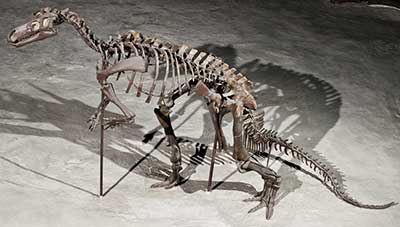Camptosaurus
(kamp-toh-SORE-us)
| Quick Facts | |
|---|---|
| Name Meaning: | Bent Lizard |
| Distribution: | Western U.S., England, Portugal |
| Time Period: | Late Jurassic-Early Cretaceous |
| Length: | 23 ft (7 m) |
| Diet: | Herbivore |
| Linnaean Classification | |
| Kingdom: | Animalia |
| Phylum: | Chordata |
| Class: | Sauropsida |
| Superorder: | Dinosauria |
| Order: | Ornithischia |
| Suborder: | Cerapoda |
| Infraorder: | Ornithopoda |
| Family: | Camptosauridae |
| Genus: | Camptosaurus |
| Cladistic Classification | |
| |

History
The Camptosaurus is one of the oldest known iguanodontids found from a complete skeleton. There have been numerous finds in Wyoming and other areas of the western United States and Europe. It was first named in 1879 by Othniel Charles Marsh. It was first named the Camptonotus meaning, "bent back," but this was later changed because Camptonotus was already in use as the name for a cricket. It was renamed Camptosaurus in 1885.Description
The Camptosaurus was a bipedal/quadrupedal dinosaur meaning it could walk on two legs or on four. For this reason it was named the, "bent lizard," because on all fours it would have appeared bent. It had a four-toed foot with small hooves at the end of each toe. It had large hind legs that may have allowed it to reach speeds of 25 miles per hour. The front legs had fused wrist bones making it easier to walk on all fours. Its neck was relatively long with a head particularly small for its size. The snout was horse-like with a beak typical of the iguanodontids. Its teeth were arranged in a uniform fashion and may have been used for tougher vegetation due to the fact that most of its teeth were worn.
ScienceViews Writer: Jason Hamilton.
Copyright © 2005-2010 Calvin & Rosanna Hamilton. All rights reserved.